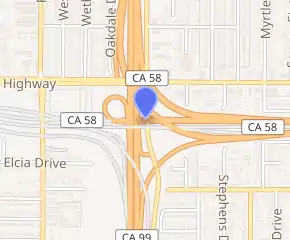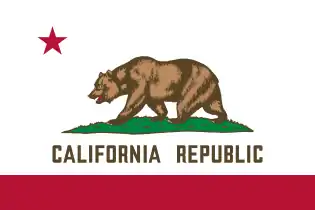West Bakersfield Interchange
The West Bakersfield Interchange is a freeway interchange in Bakersfield, California, west of downtown. It connects State Route 99 (Golden State Freeway) with SR 58 (Mojave Freeway). These routes represent the heart of the Bakersfield freeway network. They connect the city with commercial centers in the San Joaquin Valley, ports in Los Angeles, and major Interstate freeways serving southern and eastern America.
| West Bakersfield Interchange | |
|---|---|

| |
| Location | |
| Bakersfield, California | |
| Coordinates | 35°21′10″N 119°2′22″W |
| Roads at junction | |
| Construction | |
| Type | Three level stack interchange |
| Spans | 5 |
| Lanes | 4 (Mojave Freeway), 8 (Golden State Freeway) |
| Constructed | 1974–76 |
| Opened | 1976 |
| Maintained by | Caltrans |
The original interchange plan was more elaborate. Five freeway segments (three signed routes) would connect through a series of three interchanges, forming a triangle. Those routes were SR 99 (Golden State Freeway), SR 58 (Mojave Freeway/Westside Parkway), and SR 178 (Crosstown Freeway). However, only three segments and part of one interchange were constructed. Currently, SR 178 terminates about 1.5 miles (2.4 km) east of the interchange. In addition, the eastern terminus of the Westside Parkway is about one mile (1.6 km) west of the interchange.
Since the interchange is being designed relatively late, compared to other major California freeway interchanges, several design elements are incorporated to help alleviate traffic. Unlike the East Los Angeles and Orange Crush interchanges, the three Kern County interchanges will be widely spaced (between 1 and 2 miles (1.6 and 3.2 km)) from one another. Also, local interchanges within one mile (1.6 km) of it will transition onto their own parallel roads, and merge with the mainline after the main interchange.
History
The western extension as well as the northern leg of the interchange were not constructed. It was delayed first by a four-year freeway construction moratorium imposed by Governor Jerry Brown (1977–81) and was followed by 25 years of opposition from the City of Bakersfield (1980–2005).[1][2]
By the early 2000s, traffic was becoming a large enough problem that improvements needed to be completed. Federal money was secured for the construction of the southern leg of the interchange, which connects the Mojave Freeway to the Westside Parkway. This will also complete construction of the existing interchange, and provide improvements which will be incorporated into the future construction of the other two interchanges. The city would also drop its opposition to the project, with the city council voting to give Caltrans full control over it.[2] The city would retain control over the construction of the Westside Parkway.[3]
Future
Efforts are currently underway for the construction of the southern leg, as well as finishing the existing interchange. In 2005, $330 million was secured through the Safe, Accountable, Flexible, Efficient Transportation Equity Act: A Legacy for Users (SAFETEA-LU) for the construction of the Centennial Corridor. The southern leg of the interchange is a part of that project.[4] However, the project remains controversial since it would displace dozens of homes and businesses.[5]
Once completed, the interchange will not allow southbound Golden State Freeway (SR 99) traffic to transition to westbound Westside Parkway and vice versa.[6]
See also
 California portal
California portal California Roads portal
California Roads portal- Transportation in Kern County, California
References
- Cristiano, Robert (March 6, 2010). "The Failed State of California: The Changing Landscape of America". NewGeography. Retrieved March 6, 2012.
- Gaspar, Jose (March 4, 2008). "Centennial Corridor project has Westpark neighbors questioning city leaders". Bakersfield Now. Retrieved March 6, 2012.
- Staff. "Westside Parkway". Thomas Roads Improvement Program. City of Bakersfield. Retrieved March 6, 2012.
- District 6 staff. "Centennial Corridor Project". California Department of Transportation. Retrieved March 6, 2012.
- "Caltrans Picks Preferred Route For Centennial Corridor Freeway in Bakersfield". Valley Public Radio. November 15, 2012. Retrieved September 8, 2013.
- District 6 staff. "Centennial Corridor Project Alternatives". California Department of Transportation. Retrieved March 6, 2012.